Embryo Extracts
From the late 1930s onwards, a number of French companies began to include embryo extracts in their skin-care lines. French women were use to putting egg on their face – egg white could be used as a wrinkle smoothing face mask and egg yolk could be mixed with olive oil in a dry skin treatment – but this was something else.
Cosmetic companies were not alone in touting the benefits of embryo extracts at this time. For example, in the 1930s, Dr. Pierre Rosenthal’s Embryex pills containing chicken embryo extracts were advertised as a cure for ‘depression, fatigue, exhaustion, glandular deficiencies, and imbalances in the sympathetic system’.

Above: Embryex tablets.
Like other biological materials used in cosmetics – such as hormones, royal jelly and placental extract – the benefits of chicken embryo extracts were supposedly supported by scientific research. The research often cited was done decades earlier by Dr. Alexis Carrel.
Alexis Carrel
Carrel was a French surgeon, biologist and Nobel Laureate who spent much of his working life in the United States. This included an extended period with the Rockefeller Institute for Medical Research in New York. There he conducted experiments that would effect the scientific understanding of tissue cultures and cells for the next half-century.
In 1912, Carrel claimed that he had managed to maintain a culture of embryonic chicken heart cells beyond the fifteen or so days previously thought possible, and he later claimed that one particular cell line established in this period (number 725) had survived for decades (Witkowski, 1980). As this was much longer than the normal life of a chicken, Carrel used this result to support his belief that cells could grow and divide indefinitely, a conclusion that became the dominant scientific view until the 1960s.

Above: 1938 Two technicians at work in Carrel’s laboratory at the Rockefeller Institute wearing outfits adopted by Carrel for infection control.
The idea that Carrel’s chicken heart cells were ‘immortal’ was widely reported, created a good deal of public attention, and captured the interest of anyone looking into rejuvenation therapies.
Trephones
In 1922, Carrel coined the term tréphone (English: trephone) to describe substances that stimulated the continued growth and division of cells and made cell cultures ‘immortal’. He did not describe what trephones were but it was assumed that tissues associated with active cell proliferation, such as embryonic tissue, would have high concentrations of them. Cosmetic ‘logic’ follows that if trephones could be extracted and added to cosmetics then they would have beneficial proliferation and rejuvenation effects on the skin, just like they did on tissue cultures, This would make them a veritable ‘fountain of youth’. A similar line of reasoning was sometimes taken to support the use of pollen in cosmetics.
See also: Pollen Extracts
Extraction
Although embryos from other animals were occasionally used, chicken eggs were the usual source for the extracts. Fertilised eggs incubated for 8–10 days were selected because this was when cells proliferated, and therefore trephones, were thought to be maximised.

Above: 1949 An extracted chicken embryo.
The embryos were separated from the whites and yolks of the eggs using sterile instruments. They were then ground up, mixed with an isotonic Ringer-Locke solution, and then stored in ampoules to avoid bacterial contamination.
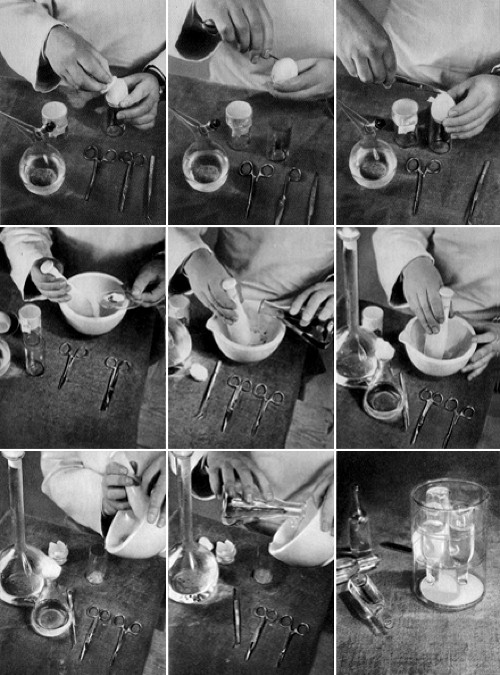
Above: 1949 Extracting a chicken embryo, grinding it up, mixing it with Ringer-Locke solution and storing it in an ampoule.
The resulting ‘vivi-sérum’ (Votre Beauté, 1949) could be kept for up to 10 days, provided it was stored at a favourable temperature. As the liquid form was of limited use, the embryo extract was usually freeze-dried so that it could be added to a wide range of cosmetics – glossing over any adverse effect this might have had on the trephones.
Benefits
Unlike hormones, placental extracts and royal jelly – all of which, to a greater or lesser extent, attracted the attention of cosmetic chemists – there seems to have been little published research into the effectiveness of embryo extracts in cosmetics and any suggested benefits were largely hearsay – despite the frequent claims by French cosmetic companies of ‘exhaustive laboratory research’. Gattefossé, for example, claims they are efficacious but does not offer any supportive evidence other than his direct observations.
Embryotherapy is an addition to vitamin therapy. During the embryo’s development a very active life goes on and its cells proliferate with unbelievable rapidity. From this there sprang the idea of their being principles governing the formation of tissues …
The problem of obtaining an efficacious embryonic material thus consists of taking young living matter, still warm, and converting it into a liquid keeping its properties in sealed capsules. Chicken embryos are usually used, and the results obtained are genuine and easily observed.
Thus embryotherapy forms part of rejuvenescence treatment in the same way as vitamin therapy does.(Gattefossé & Jonquières, 1949, p. 164)
When used in cosmetics, the ‘stimulating’ and ‘proliferating’ properties of embryo extract were said to help heal and rejuvenate skin, induce elasticity, reduce wrinkles, elevate muscle tone and even reduce swelling around the eyes.
Uses
Chicken embryo extract was used in face creams, serums and face masks, presumably in very small quantities. In many cases it was combined with other biologicals like vitamins, placental extract, horse serum, shark liver extract or royal jelly. However, it does not appear to have achieved the popularity of other animal extracts like hormones, placental extracts or royal jelly.
See also: Hormone Creams, Oils and Serums, Royal Jelly and Placental Creams and Serums
The first companies to use embryo extracts appear to have been N.-G. Payot (1938) and Retzoderme (1941). As far as I can tell, most of the firms that followed – such as Orlane, Académie, Stendhal, Jean Gatineau, Jeanne Piaubert and Harriet Hubbard Ayer – were either of French origin or had strong French connections. It was these firms that introduced embryo extracts into the United States in 1954 (Stabile, 1969).
The great beauty secret of world-famous faces, this fabulous French discovery for beautifying the skin is a beauty aid famous in Europe for many years. Until now, it has been used by only a few American women who discovered it in Paris and imported it privately. Retzoderme actually hydrates the skin the way water refreshes a flower. Developed by a well-known French scientist, it abounds with thousands of tiny cells extracted from chicken embryos—a substance remarkably effective in helping to smooth away lines, and in [the] moisturizing of aging, drying skin.
(Retzoderme advertisement, 1954)
Stendhal of Paris banishes facial fatigue lines. The secret is ‘Epithelium Jeunesse’ — a formula for a ten-day treatment that may be used safely to remove laugh or worry lines, especially around the eyes.
(Stendhal advertisement, 1961)
Orlane’s Embryo Serum kit is as good as a face lift. Made of chicken embryo, the treatment contains eight vials and takes 40 days to complete. It is compounded to take off all the dead surface cuticle from the top layer of skin and give the user a new tissue layer. In other words, it plumps up sagging skin. … Creme Intégrale contains the same embryo serum, but it is a throat cream to combat and eliminate crepiness.
(Orlane advertisement, 1966)
Decline
In 1961, any justification for the use of embryo extracts received a setback when Leonard Hayflick [b.1928] and Paul Moorhead showed that cells did not divide indefinitely as Carrel had claimed. It now seems likely that Carrel’s ‘immortal’ cell culture had been receiving new cells when the culture medium in which was maintained was replaced.
The restriction on cells to about 50 divisions – known as the Hayflick limit – is considered to be intrinsic to normal cells, either in the body or in a tissue culture. With each cell division the telomeres on DNA shorten, and this eventually reaches a point where further division is no longer possible. There are exceptions to the Hayflick limit – namely cancer cells and stem cells – but no substance in a chicken embryo extract would overcome it.
It is hard to say if this new scientific understanding affected sales of embryo extracts which continued through the 1960s. However, like hormones, royal jelly and placental extracts which were also found in cosmetics of the period, the use of embryo extracts faded away as cosmetic companies lost interest in animal extracts in general, or had their use proscribed by regulation. This is not to say that these companies stopped using biological materials altogether, most simply switched to plant extracts instead.
First Posted: 23rd September 2013
Last Update: 16th February 2022
Sources
Carrel, A. (1912). On the permanent life of tissues outside of the organism. Journal of Experimental Medicine. 15 516-528.
Freshney, R. I. (2005). Culture of animal cells: A manual of basic technique (5th ed.). Hoboken, NJ: John Wiley & Sons.
Kehoe, J.-R. (1995). The technique of the professional make-up artist (Rev. ed.). Woburn, MA: Butterworth-Heinemann.
Landecker, H. (2007). Culturing life: How cells became technologies. Cambridge, Mass: Harvard University Press.
L’embryon de poulet. (1949). Votre Beauté. 163, 36-38.
Stabile, T. (1969). Cosmetics: Trick or treat? (3rd ed.). New York: Arco Publishing Company, Inc.
Witkowski, J. A. (1979). Alexis Carrel and the mysticism of tissue culture. Medical History. 23(3) 170-296.
Witkowski, J. A. (1980). Dr. Carrel’s immortal cells. Medical History. 24(2) 129-142.

Dr. Alexis Carrel [1873-1944].
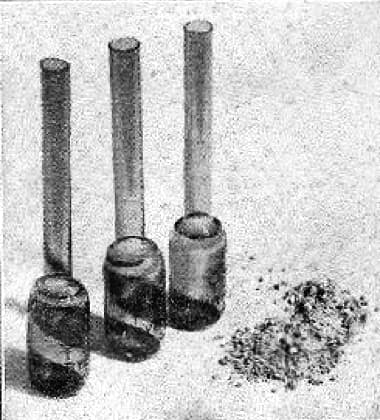
1934 Chicken embryo extract as a serum and freeze-dried powder.
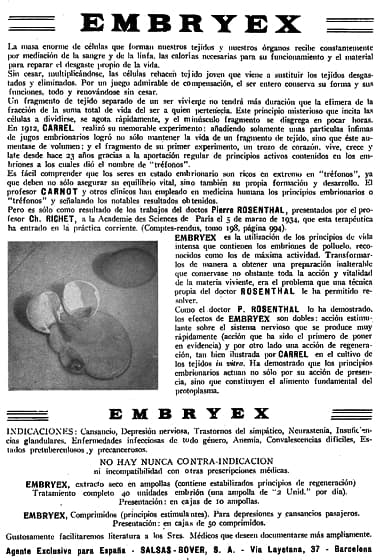
Dr. Pierre Rosethal Embryex.
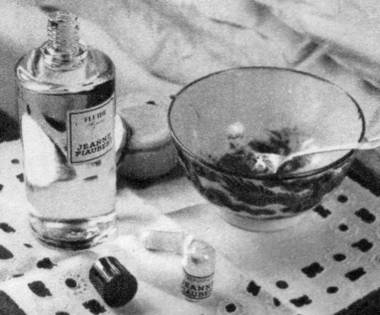
Jeanne Piaubert chicken embryo extract ampoule and mixing fluid.
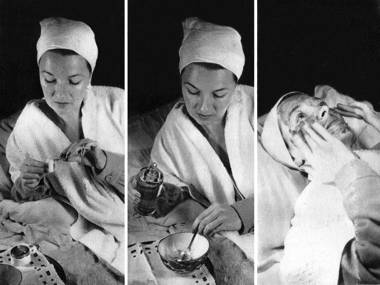
Mixing and applying a Jeanne Piaubert embryo extract masque.
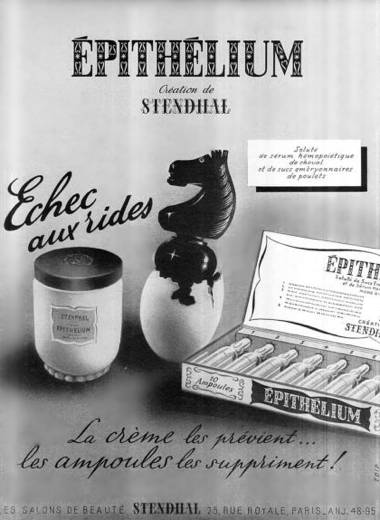
1951 Stendhal Épithélium. The jar contains embryo extract while the ampoules are made from horse serum, which explains the image of a chess knight sitting in an empty egg shell.
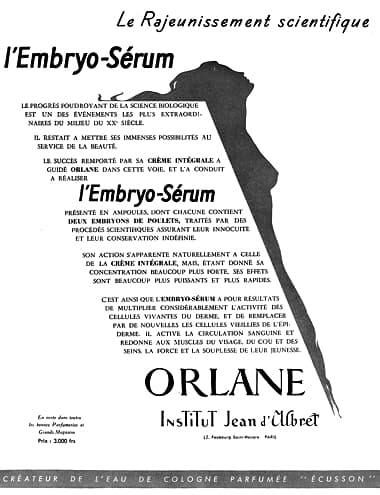
1951 Orlane Embryo-Sérum.
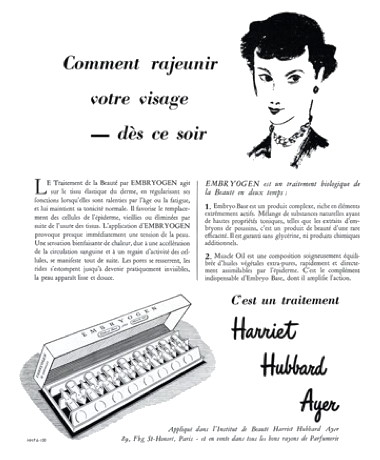
1952 Harriet Hubbard Ayer Embryogen.
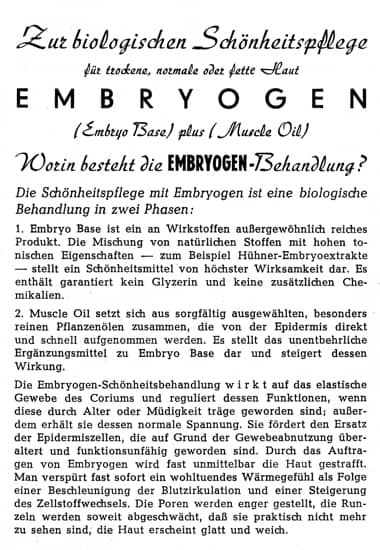
Harriet Hubbard Ayer Embryogen. Embryo Base plus Muscle Oil.
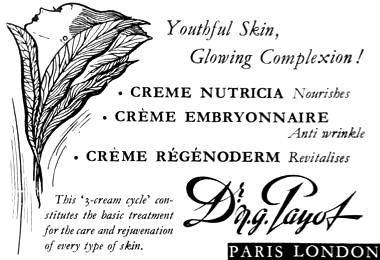
1954 Payot Crème Embryonnaire.

1956 Orlane Embryo Serum. Orlane also made Crème Intégrale containing embryo extract. Other products mentioned are: Crème Astrale containing vitamins; and Crème à la Gelée Royalé containing royal jelly.
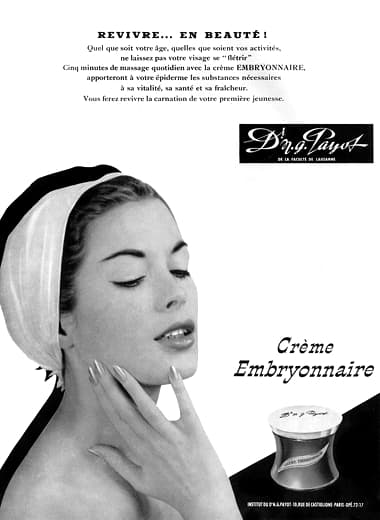
1958 Payot Crème Embryonnaire.
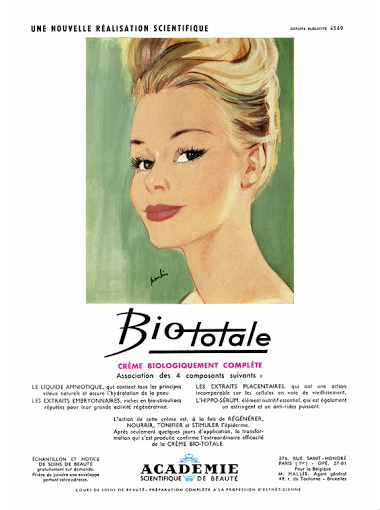
1960 Académie Bio-totale made with four biological components amniotic fluid, embryo extract, placental extract and horse serum.
